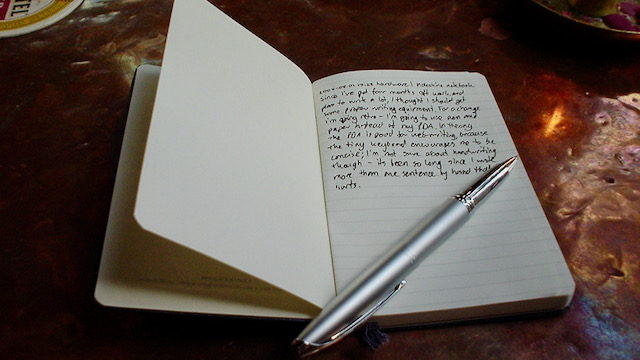Get yourself a notebook
The first step towards regularly having something to blog about 2021-10-26 #writing

- Get yourself a notebook ←
- Collect writing ideas
- Test ideas in conversation
- Reserve weekly time for writing
- Write to a shorter word limit
If you’ve ever thought about (or tried) blogging, you probably wondered how you’d know what to write about. You would have had great ideas for the first few posts, and then you’d run out.
Start collecting writing ideas, to avoid running out of things to write about. To do this:
- have lots of ideas
- write them down.
For the second step, you need to get yourself a notebook.
Choose paper or digital
Any kind of notebook will do. You might find a physical notebook easier to write in, but then you might have your phone with you more often. Actually having the notebook with you matters more than some hipster leather cover. Your ability to quickly capture a title for a blog post matters more than any app feature.
You don’t have to repeat this step for every new idea or blog post. In fact, you probably shouldn’t have more physical notebooks or notebook apps than published blog posts.
Beware of physical notebooks
Shopping for a physical notebook exposes you to substantial distraction risk. This may make you unable to choose the perfect Moleskine from among nearly 300 variants, or unable to decide whether LEUCHTTURM1917 notebooks have a higher hipster-factor (because more German).
If you enjoy shopping for and owning notebooks too much, you won’t have time to write. This gets worse when you realise that you need a pen as well, and decide that you can’t write with just any pen. Before you know it, you’ll rationalise your notebook obsession as research for blogging about notebooks, get writer’s block, and end up publishing photos of unused notebooks on Unsplash instead.

Personally, I started with a classic black hard cover pocket-sized Moleskine (photo), back in the days before smartphones. Writing in this notebook felt exceedingly satisfying, but didn’t always fit in my pocket so I didn’t always have it with me.
I later switched to the thinner soft cover cahier journals, which come in packs of three and which I found easier to carry around. I liked using these physical notebooks, except for when I couldn’t find my pen, and despite the difficulty of reading my own handwriting.
Beware of smartphone apps
Smartphone apps pose different risks. The most dangerous examples have an innovative system for organising your ideas, artificial intelligence features with uncertain applicability, overly zealous adherents, thousands of features, or all of the above.
On my smartphone, I first used a now-defunct plain text editor that synchronised text files from a Dropbox folder. These days, I use the Apple Notes app, whose elegance and simplicity I love. I also love that synchronising notes between my phone and laptop just works; I value this feature above all others.
Folders, headings and bullet lists give me enough to organise more notes than I can count, and I also appreciate fast search and backups. Anyway, who needs unnecessary features to distract you when you have to obsess over the perfect emoji to prefix each note title, to sort notes into categories?
Nurture your ideas
If you write down enough ideas, and nurture them, some will grow into blog posts. These steps, of course, present additional challenges.

